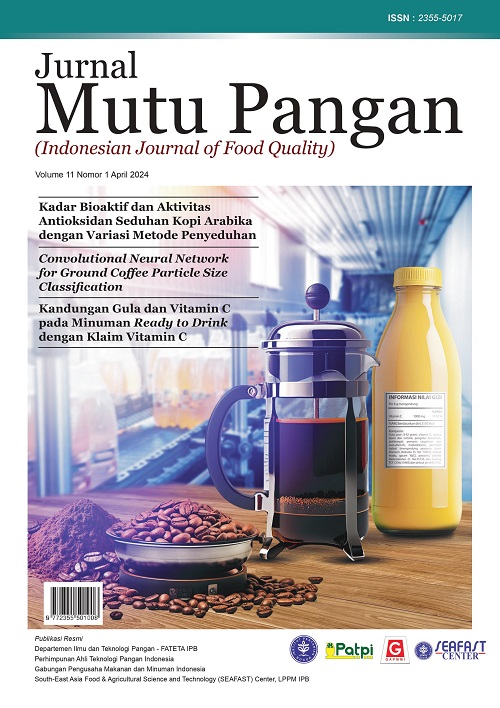Kajian Implementasi Informasi “Pilihan Lebih Sehat” Label Kemasan Mi Instan di Indonesia
Abstract
The habitual and excessive consumption of instant noodles can have adverse effects on health, primarily due to their high salt content. Patterns of excessive salt intake in food consumption are a contributing factor to the prevalence of non-communicable diseases. The Indonesian government has issued labeling regulations regarding the inclusion of information on sugar, salt, fat content and health messages to educate the public in monitoring their daily salt intake independently. This study aims to identify the information provided on instant noodle packaging. The research comprises of inventory and identification of instant noodle packaging labels, as well as the processing of data from these labels. According to the nutrition fact, instant noodle soup has an average salt (sodium) content of 1627.65 mg/100 g and contributes to 109% of the recommended daily salt intake. Salt content in instant noodle soup is higher than in fried instant noodles. Regular instant noodle products with the code ML more frequently include warning about high sugar and salt content. The “healthier choice” instant noodles product has an average sodium level of 697.84 mg/100 g and contributes 47% of the recommended daily salt intake. The total fat, sugar and salt content of the “healthier choice” noodles are 50.63, 13.78, and 36.56% respectively lower than regular fried instant noodles. Awareness of consuming instant noodles with low fat, sugar and salt content is expected to reduce the risk of non-communicable diseases.
Downloads
References
[BPOM] Badan Pengawas Obat dan Makanan. 2021. Peraturan Badan Pengawas Obat dan Makanan Nomor 20 Tahun 2021 tentang Perubahan Atas Pera-turan Badan Pengawas Obat dan Makanan Nomor 31 Tahun 2018 Tentang Label Pangan Olahan. Badan Pengawas Obat dan Makanan, Jakarta.
Elisabeth DAA, Setijorini LE. 2016. Pendugaan umur simpan mi kering dari tepung komposit terigu, keladi, dan ubi jalar. J Matematika Sains dan Teknol 17(1): 20-28. DOI: 10.33830/jmst.v17i1.182.2016.
Ete AA, Suciptawati NLP, Nilakusmawati DPE. 2014. Pengelompokan berbagai merk mi instan berdasarkan kemiripan kandungan gizi dengan mengguna-kan analisis biplot. E-J Matematika 3(2): 53-63. DOI: 10.24843/MTK.2014.v03.i02.p066.
Farrand C, Charlton K, Crino M, Santos J, Rodriguez-Fernandez R, Mhurchu CN, Webster J. 2017. Know your noodles! Assessing variations in sodium content of instant noodles across countries. Nutrients 9(6): 612. DOI: 10.3390/nu9060612.
Huh IS, Kim H, Jo HK, Lim CS, Kim JS, Kim SJ, Kwon O, Oh B, Chang N. 2017. Instant noodle consumption is associated with cardiometabolic risk factors among college students in Seoul. Nutr Res Pract 11(3): 232-239. DOI: 10.4162/nrp.2017.11.3.232.
Ikrima IR, Giriwono PE, Rahayu WP. 2023. Pemahaman dan penerimaan label gizi front of pack produk snack oleh siswa SMA di Depok. J Mutu Pangan 10(1): 42-53. DOI: 10.29244/jmpi.2023.10.1.42.
Indrayana S, Palupi NS. 2014. Strategi implementasi pencantuman informasi kandungan gula, garam, dan lemak untuk pencegahan risiko penyakit tidak menular. J Mutu Pangan 1(2): 159-164.
Irrubai ML. 2015. Strategi labeling, packaging dan marketing produk hasil industri rumah tangga di Kelurahan Monjok Kecamatan Selaparang Kota Mataram Nusa Tenggara Barat. Society 6(1): 15-30. DOI: 10.20414/society.v6i1.1462.
Istiqomah N, Astawan M, Palupi NS. 2021. Assessment of sodium content of processed food available in Indonesia. J Gizi Pangan 16(3): 129-138. DOI: 10. 25182/jgp.2021.16.3.129-138.
Katmawanti S, Ulfah NH. 2016. Analisis faktor yang mempengaruhi pola konsumsi mi instant pada mahasiswa di Universitas Negeri Malang. Preventia: Indonesian J Public Health 1(2):229-242. DOI: 10.17977/um044v1i2p229-242.
[Kemenkes] Kementrian Kesehatan. 2013. Peraturan Menteri Kesehatan Republik Indonesia Nomor 30 Tahun 2013 tentang Pencantuman Informasi Kandungan Gula, Garam dan Lemak serta Pesan Kesehatan untuk Pangan Olahan dan Pangan Siap Saji. Kementrian Kesehatan, Jakarta.
Lee BY, Ferguson MC, Hertenstein DL, Adam A, Zenkov E, Wang PI, Wong MS, Gittelsohn J, Mui Y, Brown ST. 2018. Simulating the impact of sugar-sweetened beverage warning labels in three cities. Am J Prev Med 54(2): 197-204. DOI: 10.101 6/j.amepre.2017.11.003.
Pawestri HP, Febrianto W, Agustina L, Faradiba N. 2022. Pengaruh angka kecukupan gizi (AKG) terhadap per-sonal branding umkm makanan ringan Mr. Gelenk. J Aplikasi Inovasi Ipteks SOLIDITAS 5(1): 136-140. DOI: 10.31328/js.v5i1.3582.
Sundari R. 2017. Analisis keputusan pembelian konsu-men terhadap produk mie instan (studi kasus pada mahasiswa/i STIE Riau Pekanbaru). J Eko Bisnis: Riau Economic and Business Review 8(1): 153-162.
Tan CH, Chow ZY, Ching SM, Devaraj NK, He FJ, MacGregor GA, Chia YC. 2019. Salt content of instant noodles in Malaysia: A cross-sectional study. BMJ Open 9(4): 1-10. DOI: 10.1136/bmjopen-2018-024702.
Tridayanti F, Nurfebiaraning S. 2022. The influence of NCT Dream as brand ambassador on brand image of Lemonilo instant noodle product through young generation. Medium 10(2): 67-80. DOI: 10.25299/medium.2022.vol10(2).10091.
Wowor M, Laoh JM, Pangemanan DH. 2013. Hubungan pengetahuan dan sikap dengan pemberian ASI eksklusif pada ibu menyusui di Puskesmas Bahu Kota Manado. E-J Keperawatan 1(1): 1-7.

















